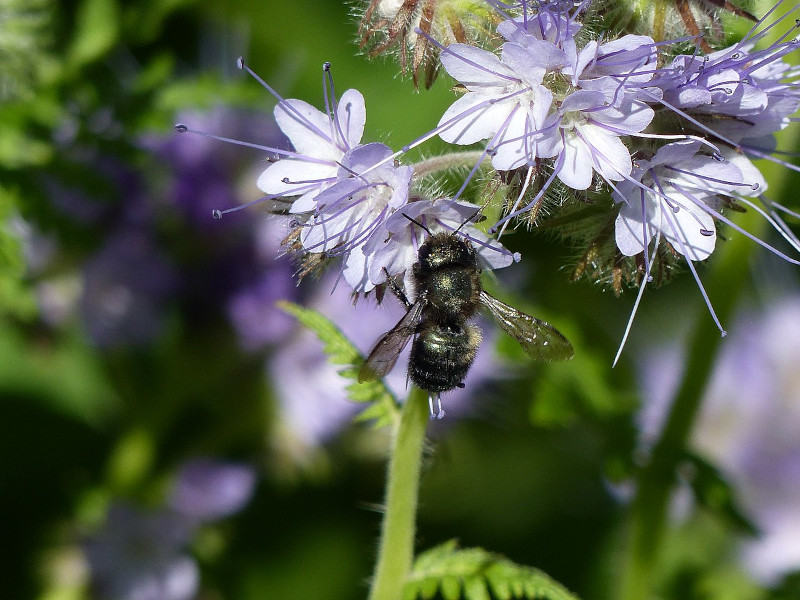
Blue Orchard Bee Facts
- This small yet still intriguing invertebrate is most frequently referred to by the descriptive common name of the Blue Orchard Bee. The delicate Arthropod does have another, similar general name, though. That’s the slightly longer term of the Orchard Mason Bee.
- Within the scientific community, however, it’s typically referred to by its technical moniker. Fortunately for the layperson, that’s a much simpler name to pronounce than many of its countless relatives hold. That’s because it bears the official name of Osmia lignaria.
- The wonder received that specific appellation due to the efforts of the respected American entomologist, Thomas Say. The researcher accomplished the first formal recognition of it as a separate and distinct species. That scientifically noteworthy deed occurred in the 1837.
- It’s of great interest in certain circles, due to its extreme proficiency at pollinating certain crops. Long term geographical separation of its population eventually led to its division into two separate subspecies. One appears in the east, while the other lives in the west.
- In all parts of its range, however, the Blue Orchard Bee continues to maintain a sizeable and sufficient population base. That sets it apart from many of its less fortunate relatives across the globe. Due to this situation, the IUCN currently has no listing for it on the Red List.
- Nevertheless, this marvel of Nature and evolution must be considered to be facing several potential threats to its existence as a species. Most of these stem from the actions of humans. They include the perils posed by habitat loss, and of course, ongoing climate change.
Related Articles
Blue Orchard Bee Physical Description
The captivating Blue Orchard Bee certainly merits the attention typically applied to it. It represents a true masterpiece of evolution. The majority of its physical appeal, however, stems from its appearance, not size. That’s because, regardless of its many other attributes, it’s quite small.
Regarding its physical attributes, though, it follows a pattern quite common to many related species. That’s in the fact that it displays a certain degree of the physiological characteristic of sexual dimorphism. In its specific case, this trait manifests in terms of body size and body structure.
Females of this insect attain a greater average length than their male counterparts. This gender reaches an average length measuring roughly 0.55 in (1.4 cm). The body shape of the female also differs from the male of the species, though only slightly. Females evloved as stockier in build.
Males of the invertebrate, though only reach a total length averaging approximately 0.43 in (1.1 cm). As indicated above, their overall structure also remains somewhat slimmer than females. He also has longer antennae, since these have 13 segments, while the female has 12 of these sections.
The genders of the Blue Orchard Bee additionally vary to a small degree in their general appearance. Females of this natural wonder present a primarily iridescent bluish-gray that sometimes seems almost black. Her body further possesses a relatively dense covering of very small hairs.
The male, meanwhile, follows the same overall pattern, with the exception of some minor yet notable differences. He typically develops a small tuft of lighter colored hair on his head. Although he displays the same covering of fine hairs on his body, that’s less dense on the upper side.
- Kingdom: Animalia
- Phylum: Arthropoda
- Class: Insecta
- Order: Hymenoptera
- Family: Megachilidae
- Genus: Osmia
- Species: O/ lignaria
Blue Orchard Bee Distribution, Habitat, and Ecology
Thankfully, the amazing Blue Orchard Be evolved as indigenous to a comparatively wide expanse of the globe. The full extent of that range might surprise some readers, though. That’s true since this intriguing insect developed as endemic to an extensive portion of North America.
To the north, the intrepid invertebrate appears in all but the most northerly regions of Canada. Further south, it makes its home in all but the most southerly parts of the United States. It’s absent from Florida, and the southeast Gulf Coast, though. It’s not presently known in Mexico.
In all regions in which it appears, the Arthropod displays decidedly strong preferences regarding its choice of habitat. The creature lives almost exlusively in regions of temperate forests. Further specifying its tastes, these areas of habitation consist primarily of various deciduous species.
For undetermined reasons, however, even within this area, the fascinating creature also shows a strong favoritism for the edges of the forest. Such an environment provides it with its various needs. Those include suitable locations for both its nesting and appropriate food sources.
Unlike carpenter bees, the Blue Orchard Bee evolved as wholly unable to drill holes in wood for a nest. Instead, it seeks out such sites as reeds and natural holes in trees, even wooden structures. Though mostly solitary in nature, females do occasionally build nests near each other.
They’re principally active in early spring and summer periods of the year. Though examples feed on the nectar and pollen of numerous species, most do appear to be especially fond of pear, apple, and cherry trees. Males typically hatch first, and the first thing females do upon hatching is mate.
Species Sharing Its Range
Check out our other articles on 5 Marvelous Mediterranean Sea Species, Mangrove Monitor, Cumberland Falls, Appalachian Avens, Bluespotted Ribbontail Ray, Harp Seal, Rose’s Ghost Frog
